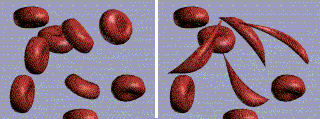Hemoglobin Sickle C Disease
Child with Hemoglobin Sickle C Disease
Hemoglobin sickle C disease is a "mild" form of sickle cell anemia. Your child's red blood cells (RBC's) contain two abnormal hemoglobins, called hemoglobin S and hemoglobin C.
Hemoglobin is the substance in the RBC's which carries oxygen to all parts of the body. Instead of appearing round (donut-shaped), your child's RBC's are somewhat misshapen, and some even appear like the sickle-shaped cells found in sickle cell anemia. Others are folded or football-shaped.

How Hemoglobin Sickle C Disease is Inherited
| Mother with sickle trait |  |
Father with C trait |
When one person has sickle trait and the other parent has C trait, each baby has a one in four chance of inheriting Sickle C disease.
Problems Seen in Children with Sickle C Disease
Your child will always have a slight decrease in his blood count – this is called anemia. Except for occasionally causing tiredness and or weakness in some children, the mild anemia usually does not cause any problems.
Pain
The red blood cells of Sickle C (SC) disease are rigid and stiff and many sometimes "clog up" the small vessels in the bones and other parts of the body. Because enough oxygen cannot get into the bones, this can cause pain. Painful episodes to occur most commonly in the arms, legs, stomach, and back. These episodes can last for hours, days, or up to a week. The pain can vary from mild to moderate to severe. The location, length, and degree of pain, can vary from episode to episode. How often these crises occur is variable. Some children with SC disease have no crises at all, but most will have a few each year.
Pneumonia and Other Infections
A child with SC disease has an increased risk of getting certain infections, particularly pneumonia. The abnormal RBC's can "clog up" in the lungs and increase the risk of infection there. This is called acute chest syndrome. Symptoms to watch for include: fever, fast breathing, trouble breathing, retractions (ribs "suck in" when breathing), very congested cough, and chest pain. If these occur, your child needs to see a doctor immediately.
Spleen
The spleen is normally a small organ located on the upper left side of the abdomen up under the rib cage. It acts as part of the body's defense system that fights infection by removing bacteria (germs) from the blood. Children with SC disease may have an enlarged (big) spleen but this does not happen until they are about five years or older. This big spleen usually does not cause any problems. Occasionally, teenagers and adults may have pain over the spleen and a drop in the number of red blood cells - this is called a "spleen crisis."
Eyes
Older children (over age 10 years) and adults with SC disease may develop damage to the retina in the back of the eye. This may cause blindness if it is not treated in time. Regular eye check-ups by an ophthalmologist (medical eye doctor) are necessary to diagnose and treat this problem in its early stages.